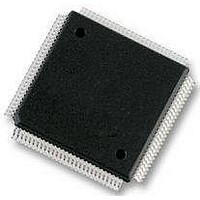MC9S12E128CPV Freescale Semiconductor, MC9S12E128CPV Datasheet - Page 116

MC9S12E128CPV
Manufacturer Part Number
MC9S12E128CPV
Description
Microcontrollers (MCU) 16 Bit 16MHz
Manufacturer
Freescale Semiconductor
Datasheet
1.MC9S12E128CPV.pdf
(606 pages)
Specifications of MC9S12E128CPV
Data Bus Width
16 bit
Program Memory Type
Flash
Program Memory Size
128 KB
Data Ram Size
8 KB
Interface Type
SCI, SPI
Maximum Clock Frequency
25 MHz
Number Of Programmable I/os
92
Number Of Timers
16 bit
Operating Supply Voltage
3.135 V to 5.5 V
Maximum Operating Temperature
+ 85 C
Mounting Style
SMD/SMT
Package / Case
LQFP-112
Minimum Operating Temperature
- 40 C
On-chip Adc
10 bit
On-chip Dac
8 bit, 2 Channel
Lead Free Status / Rohs Status
No RoHS Version Available
Available stocks
Company
Part Number
Manufacturer
Quantity
Price
Company:
Part Number:
MC9S12E128CPVE
Manufacturer:
Freescale Semiconductor
Quantity:
10 000
- Current page: 116 of 606
- Download datasheet (4Mb)
Chapter 2 128 Kbyte Flash Module (FTS128K1V1)
2.4.2
2.4.2.1
If the MCU enters wait mode while a Flash command is active (CCIF = 0), that command and any buffered
command will be completed.
The Flash module can recover the MCU from wait mode if the interrupts are enabled (see
2.4.2.2
If the MCU enters stop mode while a Flash command is active (CCIF = 0), that command will be aborted
and the data being programmed or erased is lost. The high voltage circuitry to the Flash array will be
switched off when entering stop mode. CCIF and ACCERR flags will be set. Upon exit from stop mode,
the CBEIF flag will be set and any buffered command will not be executed. The ACCERR flag must be
cleared before returning to normal operation.
2.4.2.3
In background debug mode (BDM), the FPROT register is writable. If the MCU is unsecured, then all
Flash commands listed in
mode, the only possible command to execute is mass erase.
2.4.3
The Flash module provides the necessary security information to the MCU. After each reset, the Flash
module determines the security state of the MCU as defined in
(FSEC)”.
The contents of the Flash security/options byte at address 0xFF0F in the Flash configuration field must be
changed directly by programming address 0xFF0F when the device is unsecured and the higher address
sector is unprotected. If the Flash security/options byte is left in the secure state, any reset will cause the
MCU to return to the secure operating mode.
2.4.3.1
The MCU may only be unsecured by using the backdoor key access feature which requires knowledge of
the contents of the backdoor key (four 16-bit words programmed at addresses 0xFF00–0xFF07). If
KEYEN[1:0] = 1:0 and the KEYACC bit is set, a write to a backdoor key address in the Flash array triggers
a comparison between the written data and the backdoor key data stored in the Flash array. If all four words
of data are written to the correct addresses in the correct order and the data matches the backdoor key
stored in the Flash array, the MCU will be unsecured. The data must be written to the backdoor key
116
Operating Modes
Flash Module Security
Wait Mode
Stop Mode
Background Debug Mode
Unsecuring the MCU using Backdoor Key Access
As active Flash commands are immediately aborted when the MCU enters
stop mode, it is strongly recommended that the user does not use the STOP
instruction during program and erase execution.
Table 2-16
MC9S12E128 Data Sheet, Rev. 1.07
can be executed. If the MCU is secured and is in special single chip
NOTE
Section 2.3.2.2, “Flash Security Register
Freescale Semiconductor
Section
2.4.5).
Related parts for MC9S12E128CPV
Image
Part Number
Description
Manufacturer
Datasheet
Request
R
Part Number:
Description:
Manufacturer:
Freescale Semiconductor, Inc
Datasheet:
Part Number:
Description:
Manufacturer:
Freescale Semiconductor, Inc
Datasheet:
Part Number:
Description:
Manufacturer:
Freescale Semiconductor, Inc
Datasheet:
Part Number:
Description:
Manufacturer:
Freescale Semiconductor, Inc
Datasheet:
Part Number:
Description:
Manufacturer:
Freescale Semiconductor, Inc
Datasheet:
Part Number:
Description:
Manufacturer:
Freescale Semiconductor, Inc
Datasheet:
Part Number:
Description:
Manufacturer:
Freescale Semiconductor, Inc
Datasheet:
Part Number:
Description:
Manufacturer:
Freescale Semiconductor, Inc
Datasheet:
Part Number:
Description:
Manufacturer:
Freescale Semiconductor, Inc
Datasheet:
Part Number:
Description:
Manufacturer:
Freescale Semiconductor, Inc
Datasheet:
Part Number:
Description:
Manufacturer:
Freescale Semiconductor, Inc
Datasheet:
Part Number:
Description:
Manufacturer:
Freescale Semiconductor, Inc
Datasheet:
Part Number:
Description:
Manufacturer:
Freescale Semiconductor, Inc
Datasheet:
Part Number:
Description:
Manufacturer:
Freescale Semiconductor, Inc
Datasheet:
Part Number:
Description:
Manufacturer:
Freescale Semiconductor, Inc
Datasheet:











